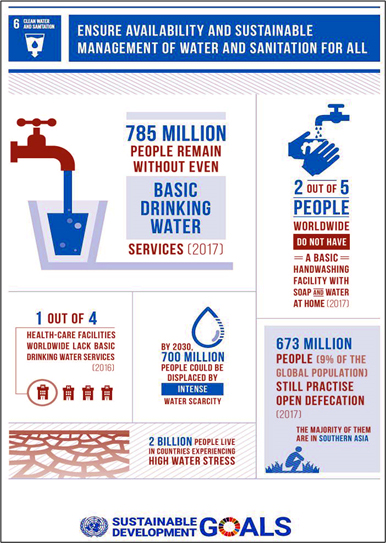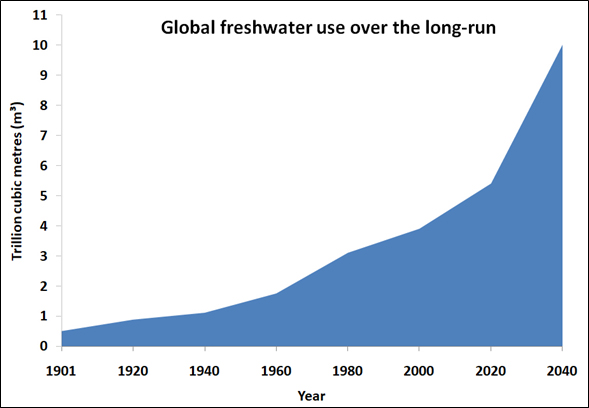Student Contributors:
Abikhit Chatterjee, M.Sc. Biotechnology, Sem-II, SoLB, AU
Maitreyee Sengupta, B.Sc. Biotechnology, Sem-IV, SoLB, AU
The Fact:
“Water water everywhere, nor any drop to drink”
― Samuel Taylor Coleridge, The Rime of the Ancient Mariner

Source: https://www.un.org/en/sections/issues-depth/water/
The above-quoted line is depicting the level of difficulty that we are expecting to face shortly. Though we know that our earth’s surface is covered by 2/3rd of water but out of this 2/3rd, only 3% of water is suitable for drinking purposes. Many arid regions in the world are already in a critical condition, facing the difficulty of the scarcity of freshwater resources and the need for additional water supplies is increasing day by day and it will be increasing to a much higher rate in the coming future.
According to the World Health Organization (WHO), washing hands with soap and water is one of the most effective and useful methods we can take to prevent the spread of pathogens and prevent infections. Even it is found to be very effective in stopping the spread of novel coronavirus (SARS-CoV-2). Hence, the demand for safe water is going to increase day by day.

Figure 1: Projected freshwater use in global scenario
According to a survey report carried out in 2019, there are around 2.1 billion people that are living without a proper supply of safe drinking water in their homes and this problem will be increasing soon and by around 2050, there will be a severe shortage of freshwater sources and out of every 4 people, 1 people will be residing in an area having a severe shortage of freshwater sources (https://www.worldvision.org/).
Out of several goals set by the United Nations (UN) in 2018 to overcome this situation, the goal number 6 was to ensure that all the people residing in this huge world should have proper access to water and sanitization. Every day, thousands of death cases are being reported and as per the report it can be seen that death is occurring mostly in children and the main reason behind this death is the unavailability of proper drinking water and sanitization (https://www.un.org/sustainabledevelopment/water-and-sanitation/).
This is to be noted that, March 22 is celebrated as World Water Day by the United Nations to measure the progress rate that the world is making in providing safe water for drinking and hygiene purpose to the people. The United Nations General Assembly, in December 2016 adopted a resolution “International Decade (2018-2028) for Action –Water for Sustainable Development”. It was adopted to mainly help in putting a greater focus on water for the coming ten years (https://www.un.org/sustainabledevelopment/water-action-decade/).
Recent statistics say, approximately 6 liters of water per minute is being used by a running tap. A normal hand washing for 20-30 seconds, can use approximately 3.5 liters of water if the tap is kept on or it can use approximately 2 liters of water if the tap is kept closed while scrubbing our hands with soap. A family comprising of five members would spend approximately 100-200 liters of water per day only to wash their hands 10 times a day as compared to 4-5 times hand washing a day as usual.

Figure 2: Use of water in day to day life
Does Biotechnology have a solution to combat the situation?
Our lifespan would last for approximately 14 days without water. Our entire survival is closely dependent on one single, exhaustible natural resource. Biotechnology has a large impact on industries such as the plant, agriculture, and pharmaceutical sector, but its role in water technology is ready for the new beginning.
The major sources of drinking water are surface water and groundwater. Both forms of water are generally not safe at the source and require some form of treatment to consider it as potable. Hence, water treatment technology is an area of vital importance in the global as well as Indian context and it is of utmost importance for any government to launch missions on environmental biotechnology, to meet the basic needs of safe and pure drinking water and hygienic sanitation facilities for the people.
Certain cutting-edge technologies are available for the treatment of raw water supplies, for industry or large communities are the following:
Desalination:
There are only a few underground resources available but the water is becoming saline day by day due to the extraction of water from aquifers. However, to produce rain naturally, which is the main source of freshwater on earth, a process known as solar desalination evaporation is carried out.
Saline water can be made into freshwater, which has many uses. The process is termed as “desalination”, and it is being used often around the world to provide people with needed freshwater. The major challenge is to remove the dissolved salt in seawater. Now Floating distillation is a technique in which a machine that is named as ‘floating solar still’ is based on. That uses the mechanism of evaporation and condensation.
Reverse osmosis (RO):
Another way to desalinize the seawater is by the “reverse osmosis” procedure. In simple language, water, which contains dissolved salt molecules, is run through a semipermeable membrane against osmotic pressure (which is a filter), in which the larger salt molecules do not get through the membrane holes but the smaller water molecules do.
Forward Osmosis (FO):
FO is an emerging water filtration/purification technology that uses an osmotic pressure difference to drive water across a semipermeable membrane. Due to its potential applications in several areas, including food and drug preparation, desalination and power production, research on FO membranes has increased exponentially.
Electrodialysis (ED):
ED utilizes electric current to separate ions from water. ED consists of different cell compartments separated by selective ion exchange membranes; under applied direct current, the ions move toward the electrodes by passing through these selectively permeable membranes.
Nanotechnology in Water Purification:
Membrane-based water purification is an energy and waste efficient method to remove molecular pollutants. ‘Increased water throughput, high filter efficiency, and high molecular loading capacity are the primary aim for designing water membrane-based purification.
Biomimetic nanotechnology would be a promising technology for water purification:
Various types of channel proteins, broadly named porins, present in the cell membrane of Gram-negative bacteria have specific functionalities depending on their selectivity toward various nutrients or toward the water. The high selectivity of porins has led to their incorporation into synthetic systems, in a field called “biomimetics”. The concept of incorporating aquaporins into synthetic membranes has been observed in recent years. Hence, the next generation of water filtration technology is about to improve using biomimetic membranes.
In summary, India had always nurtured creative research minds who always came up with a solution in the time of crisis. The future of biomimetic and bioinspired membranes depends on the design strategies, level of nature imitation, and the performance of these systems on a commercial scale. In this blog, we have compiled some of the best water technology and water treatment companies in India such as VА Тесh Wаbаg, Тhеrmах Іndіа, GE Wаtеr, Siemens India – Water Technologies, Аquа Іnnоvаtіvе Ѕоlutіоnѕ, Suez Water Technologies & Solutions, Iоn Eхсhаngе Іndіа Ltd, Toshiba Water Solutions Pvt. Ltd, Wipro Water, etc. They all are doing a fantastic job of making our society better by providing safe water and there will be an enormous scope of the job for the biotechnologist soon.
Further reading:
Fowler, S. J., & Smets, B. F. (2017). Microbial biotechnologies for potable water production. Microbial biotechnology, 10(5), 1094-1097.
Kirisits, M. J., Emelko, M. B., & Pinto, A. J. (2019). Applying biotechnology for drinking water biofiltration: advancing science and practice. Current opinion in biotechnology, 57, 197-204.
Wagh, P., & Escobar, I. C. (2019). Biomimetic and bioinspired membranes for water purification: A critical review and future directions. Environmental progress & sustainable energy, 38(3), e13215.
Fuwad, A., Ryu, H., Malmstadt, N., Kim, S. M., & Jeon, T. J. (2019). Biomimetic membranes as potential tools for water purification: Preceding and future avenues. Desalination, 458, 97-115.





